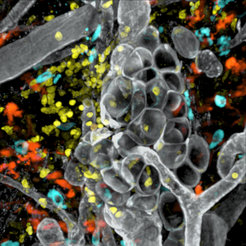Immune Cell Dynamics
Lab Lämmermann
Immune responses are highly dynamic and require coordinated migration, tissue positioning and interactions between immune cells with diverse effector functions. In particular, within minutes of tissue damage or incipient infection, cells of the innate (non-specific) immune system undertake a coordinated, multi-cellular and multi-layered response to isolate sites of tissue damage and microbial invasion from healthy tissue.

Several myeloid immune cell types act at the front line of this host innate immune defense. Some of them (neutrophils, monocytes) circulate through the bloodstream and only exit the vessel at sites of acute inflammation, whereas others (macrophages, dendritic cells, mast cells) already reside in peripheral tissues or draining lymph nodes. The spatiotemporal coordination of these events occurs on the single cell and population level. Single cell processes involve the interplay of actin network expansion, contraction, and adhesion, which shape the exact migration mode of each myeloid cell type (Lämmermann & Germain, 2014). Moreover, specific expression patterns of multiple G-protein coupled receptors allow cell type specific directional decisions and navigation routes of individual cells in each immune cell population (Lämmermann & Kastenmüller, 2019). On top, intercellular communication between immune cell populations are required to coordinate all single cell responses for the successful initiation and establishment of an innate immune response (Kienle & Lämmermann, 2016).
In our research, we are particularly interested how single cell and population processes impact (a) the sensing, detection and elimination of damaged tissues and dead cell material, (b) the specific migration patterns and strategic positioning of immune cell subsets to initiate immune responses, (c) the communication within one or between several immune cell populations for the optimal coordination of innate immune responses during wounding, inflammation, infection and anaphylaxis.
In our lab, we have several projects that fall under the following categories and address the before mentioned biological aspects (for more details, see project pages):
